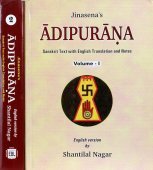Harivamshapurana, Harivaṃśapurāṇa, Harivamsha-purana: 2 definitions
Introduction:
Harivamshapurana means something in Hinduism, Sanskrit. If you want to know the exact meaning, history, etymology or English translation of this term then check out the descriptions on this page. Add your comment or reference to a book if you want to contribute to this summary article.
The Sanskrit term Harivaṃśapurāṇa can be transliterated into English as Harivamsapurana or Harivamshapurana, using the IAST transliteration scheme (?).
In Hinduism
Dhanurveda (science of warfare)
Source: Knowledge Traditions & Practices of India: Martial Arts Traditions: A SurveyHarivaṃśapurāṇa (हरिवंशपुराण) is the name of a Sanskrit text partly dealing with the ancient Indian science of martial arts (dhanurveda).—According to the Harivaṃśa Purāṇa, both Śrī Kṛṣṇa and his brother Balarāma were masters of the art of wrestling. Śarira-bala (physical strength) was gained through various krīḍa (games) including the martial arts. Various disciplines such as śastravidyā, knowledge of arms, dhanurvidyā, archery, khaḍgavidyā, aśvārohaṇa, horse riding and fighting on horseback, and gajarohaṇa, fighting on elephant back, were widely practised. The gadā or mace was also used during these bouts.

Dhanurveda (धनुर्वेद) refers to the “knowledge of warfare” and, as an upaveda, is associated with the Ṛgveda. It contains instructions on warfare, archery and ancient Indian martial arts, dating back to the 2nd-3rd millennium BCE.
Languages of India and abroad
Sanskrit dictionary
Source: Cologne Digital Sanskrit Dictionaries: Monier-Williams Sanskrit-English DictionaryHarivaṃśapurāṇa (हरिवंशपुराण):—[=hari-vaṃśa-purāṇa] [from hari-vaṃśa > hari] n. Name of [work]
Sanskrit, also spelled संस्कृतम् (saṃskṛtam), is an ancient language of India commonly seen as the grandmother of the Indo-European language family (even English!). Closely allied with Prakrit and Pali, Sanskrit is more exhaustive in both grammar and terms and has the most extensive collection of literature in the world, greatly surpassing its sister-languages Greek and Latin.
See also (Relevant definitions)
Partial matches: Harivamsha, Puraana, Purana.
Query error!
Full-text (+267): Harivamsha, Gandhavvaya, Bhattubana, Naravahana, Agnimitra, Rasabha, Vasumitra, Murunda, Palaka, Pushpamitra, Gupta, Purudvat, Matinara, Duduha, Vishaya, Sthandileya, Madresha, Purujati, Madreshvara, Bahuratha.
Relevant text
Search found 17 books and stories containing Harivamshapurana, Harivaṃśa-purāṇa, Harivamsa-purana, Harivaṃśapurāṇa, Harivamsapurana, Harivamsha-purana; (plurals include: Harivamshapuranas, purāṇas, puranas, Harivaṃśapurāṇas, Harivamsapuranas). You can also click to the full overview containing English textual excerpts. Below are direct links for the most relevant articles:
Paumacariya (critical study) (by K. R. Chandra)
9.5. Influence on Jinasenasuri and Hastimalla < [Chapter 6 - Sources, contribution and influence of Paumacariyam]
1. Genealogy of the Ikshvaku Vamsa dynasty < [Chapter 5 - Origin and Genealogy of Various Vamshas]
3. Genealogy of the Vidyadhara Vamsa dynasty < [Chapter 5 - Origin and Genealogy of Various Vamshas]
Harivamsha Purana (by Manmatha Nath Dutt)
Chapter 49 - The Fruits of the Recitation of Harivamsha < [Book 3 - Bhavishya Parva]
Notices of Sanskrit Manuscripts (by Rajendralala Mitra)
Page 318 < [Volume 6 (1882)]
Atharvaveda and Charaka Samhita (by Laxmi Maji)
Bharadvāja (Āyurveda scholar) < [Chapter 1 - Introduction]
Yasastilaka and Indian culture (Study) (by Krishna Kanta Jandiqui)
Chapter 17b - Other Jain legends
8. Metres used by Somadeva < [Chapter 7 - Yasastilaka as an Anthology of Sanskrit verse]
Tattvartha Sutra (with commentary) (by Vijay K. Jain)
Verse 3.31 - The duration of life in the five Videha regions < [Chapter 3 - The Lower World and the Middle World]
Verse 6.5 - Subdivisions of influx of ‘sāmparāyika’ karmas < [Chapter 6 - Influx of Karmas]
Related products
